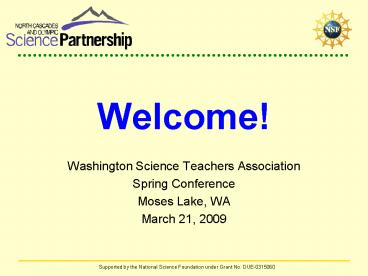Washington Science Teachers Association - PowerPoint PPT Presentation
1 / 27
Title: Washington Science Teachers Association
1
Welcome!
- Washington Science Teachers Association
- Spring Conference
- Moses Lake, WA
- March 21, 2009
2
Contact information
- Mark Emmet
- North Cascades and Olympic Science Partnership
- Mark.Emmet_at_gmail.com
3
Session Goals
- An understanding of factors that contribute to
student success based on research from
turnaround schools - An understanding of NCOSP tools and resources
that can help support student success
4
What are key factors that limit the academic
success of students in school?
5
Factors that limit student success
- List them here.
6
Why Some Schools with Latino ChildrenBeat The
Oddsand Others Dont
- What does it take to get great results in
educational achievement in a school with a
student enrollment that is mostly Latino, mostly
poor, and has many students who are still
learning English?
Center for the Future of Arizona and the Morrison
Institute for Public Policy, 2006
7
Why Some Schools with Latino ChildrenBeat The
Oddsand Others Dont
- Student scores in 3rd 8th grade for 8 years
- Improvement that exceeded predictions
- Ethnicity and poverty indicators
- Matched comparison
Selection Criteria
Center for the Future of Arizona and the Morrison
Institute for Public Policy, 2006
8
Why Some Schools with Latino ChildrenBeat The
Oddsand Others Dont
- KEY FINDINGS
- Class size
- Money
- Number of school days
- Number of NCLB Highly Qualified teachers
- Teacher Turnover
- Parent Involvement
- 12 schools
- 3 Steady Performers
- 9 Steady Climbers
- Comparison sites
Center for the Future of Arizona and the Morrison
Institute for Public Policy, 2006
9
Common Factors
- Disciplined Thought
- Clear Bottom Line
- Ongoing Assessment
10
Common Factors
- Disciplined People
- Strong and Steady Principal
- Collaborative Solutions
11
Common Factors
- Disciplined Action
- Stick with the Program
- Personalized Intervention
12
Gaining Traction, Gaining GroundHow Some High
Schools Accelerate Learning for Struggling
Students
- What do we know about the characteristics and
practices of schools that are especially
effective at improving the academic performance
of previously low-performing students?
Education Trust, 2005
13
Gaining Traction, Gaining GroundHow Some High
Schools Accelerate Learning for Struggling
Students
- Greater than expected growth over 3 years
- At least average performance
- Achievement gaps smaller than state average
- High poverty High non-White enrollment
Selection Criteria
Education Trust, 2005
14
Gaining Traction, Gaining GroundHow Some High
Schools Accelerate Learning for Struggling
Students
Education Trust, 2005
15
Gaining Traction, Gaining GroundHow Some High
Schools Accelerate Learning for Struggling
Students
Education Trust, 2005
16
Gaining Traction, Gaining GroundHow Some High
Schools Accelerate Learning for Struggling
Students
Education Trust, 2005
17
Gaining Traction, Gaining GroundHow Some High
Schools Accelerate Learning for Struggling
Students
Education Trust, 2005
18
Making Sense of the Research
- List 2-3 differences between high impact and
average impact schools that you found
particularly striking. - Discuss your responses with your table group.
19
NCOSP Teacher LeadersImpact on Students with
Greatest Need
North Cascades and Olympic Science Partnership,
2007
20
What are key factors that limit the academic
success of students in school?
21
Granger High School
- Yakima School District
- One third of students are children of migrant
workers - 82 Latino 6 American Indian
- 84 eligible for free or reduced lunch
22
Granger High School Se Puede
- How does Granger High School support academic
success for its students? - Describe the interactions between the principal
and the studentsthe teachers - Describe the interactions between the teachers
and the students - Describe the interactions among the teachers
23
Key Factors
- Attention to Individual Students
- Focus on Effective Instruction
- Collaboration focused on instruction and students
24
NCOSP Resources
- Science Classroom Observation Guide
- Professional Learning Community Observation
Protocol - Supporting Student Success Guide
25
Supporting Student Success Guide
26
Looking at our Own Context
- How would you characterize the typical types of
interactions in your school among - the principal and the students?
- the principal and the teachers?
- the teachers and the students?
- the teachers?
27
Looking at our Own Context
- How might the Supporting Student Success Guide
be useful in improving these interactions?
28
Reflection
- How could the studies weve considered today and
the Supporting Student Success Guide help you
overcome obstacles to student academic success in
your school?































